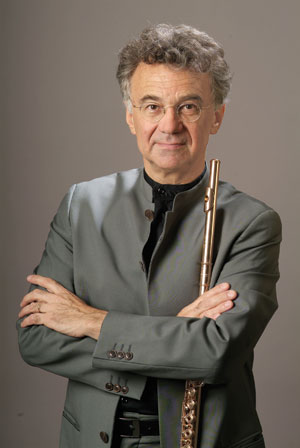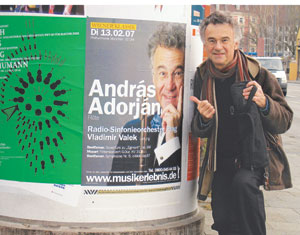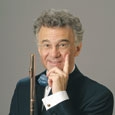 Hungarian-Danish flutist András Adorján, who currently lives in Germany, has had a long and productive career as principal flutist of orchestras in Stockholm, Cologne, Baden-Baden, and Munich, and as an educator in Germany. He is one of the foremost soloists and chamber musicians of recent times with over 100 recording projects. His most recent includes works by Erwin Schulhoff and two unpublished quartets by Georg Abraham Schneider, a German composer of Beethoven’s era, which he recorded with his two sons Gabriel, violin and Dávid, cello.
Hungarian-Danish flutist András Adorján, who currently lives in Germany, has had a long and productive career as principal flutist of orchestras in Stockholm, Cologne, Baden-Baden, and Munich, and as an educator in Germany. He is one of the foremost soloists and chamber musicians of recent times with over 100 recording projects. His most recent includes works by Erwin Schulhoff and two unpublished quartets by Georg Abraham Schneider, a German composer of Beethoven’s era, which he recorded with his two sons Gabriel, violin and Dávid, cello.
Adorján was born in Hungary, but his family moved to Denmark in 1956 when he was 12 because of the failed Hungarian Revolution. Adorján grew up in Denmark and still holds a Danish passport. His father, a medical doctor, and his mother, a physical therapist, were great lovers of music, but Adorján was the first musician in the family. “By becoming a musician, I was the first black sheep. My grandmother on my father’s side had a dance school in Budapest, which is somewhat related to music, but there were never any musicians. My sister, who is three years younger than I, plays clarinet, but she is not a musician. And now with my sons, I have added two more black sheep to the family.”
He began piano lessons when he was around 8 years old. At around age 10 he received a recorder. “What happened was the usual mistake that many parents make, thinking that flute is the next step after recorder. The oboe or the clarinet would have been a much more logical step. But since the terminology for recorder is Blockflöte and for the flute is Flöte, one can easily assume that the flute is the next step after the recorder.
“So, at age 12 I started playing the flute. I turned out to be quite talented, but then the political events happened, and with only two or three lessons on the flute, my family left Hungary. Although we took very few things with us, we did take the flute. Once in Denmark I had a lot of catching up to do, including learning a new language. We had lived in Denmark for about 3 years before I really started to play the flute.”
Adorján studied with Johan Bentzon, who played in the Danish Radio Orchestra, and later worked with Erik Thomsen, who played in the Danish Opera’s Royal Chapel. In the year before he graduated at age 18, Adorján met Bo Juel-Christiansen, a young Danish flutist who had just returned from studies with Jean-Pierre Rampal in France. “He talked about summer courses in Nice with Rampal, played Rampal’s records for me, and raved about him, so I became interested. It was so different from everything that I had heard prior. The sound, the interpretation, everything was so different.”
The serendipity of meeting this flutist and hearing Rampal was the impetus necessary to set Adorján on track to become a musician. “Flute playing before this revelation had just been a sort of obligation, part of my education. I liked to do it and was doing well, but I was not really interested. As soon as I heard Rampal, I was sure becoming a musician was what I wanted to do. Before it had never occurred to me.”
The French Influence
Adorján embarked for the International Summer Academy in Nice for the first time in 1964. He was 20 and had already started to study dentistry. “The combination of my father being a doctor, and no musical background in the family, made my mother determined that I should receive a degree in something where the diploma would automatically give me a way of earning money. At first I wasn’t too interested in dentistry, but the more I did it, the more I liked it. In fact I can well imagine having led a life as a dentist and an amateur musician!
“After 5 years of study, when I had received my dental diploma, and my mother was satisfied, I decided to see what type of life I could have as a musician. Studying for dental school was very time consuming, and as a result, I rarely had the opportunity to practice more than an hour per week. I don’t believe I accomplished a lot, but at least I didn’t lose anything. During these five years, however, I spent every summer in Nice studying with Rampal.”
Rampal was very influential on Adorján’s outlook on music. “From Rampal I learned that music is an essential part of your life; that it is like eating or sleeping, and you have to live it. When you play, you are the music itself. Of course, I learned a lot of technical aspects, but my studies with him involved more hearing and absorbing. One could describe it as imitation, but I don’t like using this word. I prefer absorption. Only if he felt that there was something you didn’t understand, would he explain. Otherwise, he would just play for you. What an inspiration! I can still recall him playing every piece I ever heard from him.”
In 1968, one week after finishing his dental studies, Adorján returned to Nice for the summer course. This time he asked Rampal if he could start studying with him and become his pupil during the year. “He said he was honored and would like to help me, but he had no teaching job. He said I couldn’t just take an airplane and follow him all around the world taking private lessons. Instead he suggested that I study with Aurèle Nicolet.”
Adorján took Rampal’s advice and headed to Freiburg, Germany to study with Nicolet at the Musikhochschule. He left there in 1970, two years before his final exam and diploma, in order to accept his first appointment as principal flute in the Orchestra of the Royal Stockholm Opera in Sweden.
The two years he spent with Nicolet were highly productive and influential to Adorján’s development as a flutist and musician. “He taught me all the basic things about flute. I think, however, that I should have studied with these two teachers in a different order. It would have been easier to put all the musical essentials that I learned from Rampal on top of the basics. Rampal assumed I knew the basics from Denmark, but I didn’t know enough. I had to start from scratch when I started with Nicolet. He could explain things very well. I was very lucky to have these two musical giants as my teachers. They were the best teachers in my life.
“Everyone has different best teachers because they are an incorporation of many things. You have to be the pupil of the teacher, as much as he has to be the teacher for the particular pupil. Everyone isn’t always fortunate to have the right match immediately. The student and teacher have to be suited to each other. I have been very lucky to have found my best teachers.”
The French School
“Before, we had two quite different schools of flute playing – the French and the German. Now there is only one school remaining. If you want to make a separation, you can only talk about a good or a bad school. Today the good seems to be a mixture of all the highlights of the French and the German schools.
“It is extremely difficult to give a definition of these former schools. You may be able to say that the French style is more instrumental, and the German advocates a more analytical way of playing. The French school may sound more intuitive. I think it becomes evident when you listen to old recordings of French and German players.
“Also, articulation is very different in the French and German schools – probably because of the language. The way Germans and French use their tongue when they speak is so different. Germans speak with the tongue quite far back in the mouth, and the French use their tongue more in front, touching the lips. Middle Europeans such as Hungarians, speak somewhere in between. It is not that the Hungarian language is especially good for flute, but the Hungarian language is so different from all the other languages that Hungarians have to learn more than one language. Most of us speak English, German, and French, so we learn to use the tongue in different ways, which helps flute playing. There’s more variety. I do in fact tongue differently depending on what the music demands. I even recommend to my students that they learn French if they are not originally French speaking.”

Orchestral Life
After two years as principal in the Royal Stockholm Opera, from 1970 to 1972, Adorján and his wife, who is also a wonderful flutist, decided to make a move. “I liked it there – it was a good orchestra and nice city, but somehow Sweden was very far away from most of my concert engagements, which were in France, Germany or England. As my wife is German, we decided to move to Germany so that at least one of us could live in our home country.”
In 1972 he won the audition in Cologne, Germany for principal flute in the Gürzenich Orchestra, which is also an opera orchestra. He held that position for a year, but found the orchestra’s heavy rehearsal and concert schedule prevented him from doing much solo work. He thought the best option to combine solo and orchestral work was to play in a symphony orchestra, but he still wanted to remain in Germany.
“The best symphony orchestras in Germany are the radio orchestras. The job was open in the Südwestfunk Symphony Orchestra in Baden Baden, which is a very nice resort city. I emphasize that is a resort city, as it is a place where one should either be a child or a retiree. It was a nice job and a wonderful city but too quiet for me.
“A year later the job in the Bavarian Radio Orchestra in Munich opened. I was successful at the audition and happy to move to Munich, the musical capital of Germany. In four years, I had played in three different orchestras. We had to move so often, each time with not only more and more furniture, but also each year with a new child. I arrived in Munich in 1974 and finally settled and stayed in this orchestra for the next 14 years.”
In 1988 Adorján left the Bavarian Radio Orchestra to take a teaching job at the Musikhochschule in Cologne. He wanted to seek out more possibilities for his solo and chamber music career, as well as find opportunities to teach. He stayed at Cologne’s Musikhochschule for ten years until he received the same position as flute professor at the Musikhochschule in Munich.
While he was teaching in Cologne, he maintained his residence in Munich, even though he was no longer playing in the orchestra. “My children were going to school there and I had friends and connections that I wanted to keep. It was quite a difficult time because I commuted between Munich and Cologne for 10 years. Fortunately a job in Munich opened up, and I could once again work in my city of residence.”
Current Projects
Due to German government requirements regarding mandatory retirement age, Adorján retired from his position at the Muskikhochschule in Munich but will teach his current students until their graduation. Adorján continues to perform and teach internationally. His schedule for 2011 includes a performance and masterclass for the New York Flute Club (Feb. 26 and 27); masterclasses at Yale, Peabody, and the New England Conservatory; performances in Germany, Sweden, Turkey, Egypt, Japan and Australia; as well as serving on the jury for an international competition in Crakow, Poland. In March he will embark on a new recording project featuring works of Beethoven and Mozart to be performed with members of the Berlin Philharmonic.
Adorján also continues to develop his interests in realms beyond performance. Along with co-editor with Lenz Meierott, he recently completed an expansive four-year project that compiled hundreds of flute-related articles into a 900-page German-edition tome: The Flute Lexicon (Lexikon der Flöte: Flöteninstrumente und ihre Baugeschichte Spielpraxis, Komponisten und ihre Werke, Interpreten, Laaber: Laaber-Verlag, 2009). Unfortunately for non-German speakers, it is only published in German, but Adorján has plans to make it available in other languages.
Two other recent projects include the facisimile manuscript of the Schubert Variations and a documentary DVD, “The Dopplers and their Musical Effects” on the life and work of the Doppler brothers. This latter project Adorján presented at the British Flute Society convention in August, 2010, followed by a recital of three Hungarian works by Franz Doppler, Antal Doráti, and Adolf Terschak.
Adorján began researching the Doppler brothers early in his flute career. As a young boy in Denmark his teacher assigned him Franz Doppler’s Hungarian Pastoral Fantasy. “When I opened the book, I immediately fell in love with it. I was amazed to discover a flute piece with Hungarian coloring.” Adorján headed for the library and found that there was not just one Doppler, but two. “I read about their lives and how they moved away from Hungary, and believed there were some parallels between us, which made me even more interested.”
Louis Lot Flutes and
Modern Tone Quality
At the British Flute Society convention Nicolas Duchamp presented a concert using Philippe Gaubert’s 1874 Louis Lot flute, No. 1986. It was the second Louis Lot flute that I had the opportunity to play, and like the other I noted that the tone quality was distinctly lighter than that of contemporary instruments. I asked Adorján about his conclusions regarding this instrument.
“The Gaubert flute doesn’t have a very big sound, if you don’t focus the air very carefully. You have to work a lot to get a good sound on it. It is not easy to play, but it has a beautiful sound quality. I hope the young flutists who heard it were as touched as I was. It is such a colorful flute. If this is the way the flute was played by Gaubert, we should return to looking for more quality than quantity in flute playing.
“We have to somehow return to the flute being a flute. The trumpet is a beautiful instrument, but let the flute be a flute. We all have a strange complex about the low register. I hope it’s a matter of fashion, and it may soon change back to what it was before.”
“For me, sound is more important than technique. Of course you need good technique, but that alone will never make people wish to hear you. A good sound is the real attraction. Learning technique, finger technique on flute, (thank you Theobald Boehm) is quite simple since everything is visible and logical. The aspect of creating a good sound is more mysterious. Tone quality is much more difficult to explain and to produce.
“The role of the diaphragm and breath control is very important and also the stream of air, of course. The technique is very similar to singing. Most people might not realize it, but they can sing with correct technique. It’s a very natural way to use the muscles of your body. If you apply a singing technique to your flute playing, then your breathing will be better. I often ask my students to sing. At first they don’t want to because they are ashamed of singing out of tune. It is not the pitch that’s important, but how you use your body. Also for natural phrasing, singing is essential.”
Advice for Students
His advice for his students and others who seek to audition for orchestras comes from his decades of experience. “Of course every orchestra demands something different, but when you take an audition, you cannot play with compromise. You cannot play pretending to be someone else. You have to play your best. If you are good, they will accept you, and then you can adapt once you join the orchestra. The conductor will help you and so will your colleagues. You will become a member – a part of that group. I think that no good orchestra will listen with prejudgment. They will look for a good musician.
“In short: the essence of flute playing is not the flute playing; it is the music. We have the possibility of making music only on the flute but after a while the actual instrument must lose its importance. One should understand and play the flute well, but when making music, the public should not admire the flute playing, but should enjoy the music. This point should be made clear for students. Even though learning the instrument takes a significant part of our time and effort, when we are finally making music, flute playing should become the most insignificant aspect.”






